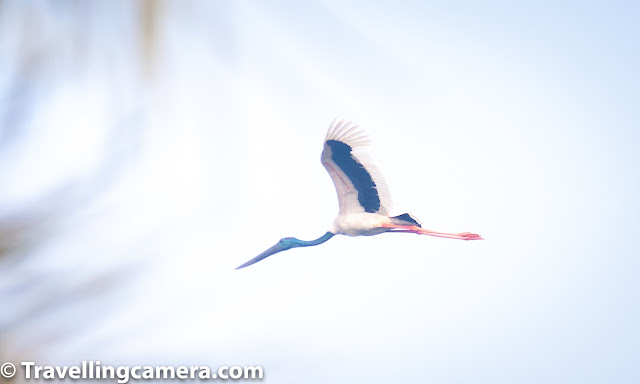This year Diwali is a little late. Mostly it is in October. However, the other traits of the month of November remain the same. Mostly we see this weather post Diwali and the very new problem of pollution because of stubble burning and fire crackers causes low motivation and morale for at least a few days every year.
November also means slight chill in the morning and an inability of get out of the bed in the morning. It means an increase in the consumption of tea and light woolens being taken out. It means 8 o' clock morning walks and slight mist (when the smog lifts on rare days). It used to be a beautiful month. But unfortunately, humans have put a stop to that. And ironically this is also the time when migratory birds start landing in India.
Even though Painted Storks are not migratory, many people mistake them for being migratory. And very few sights are as calming as that of a pair of storks tending to their babies. It is also quite amusing the see almost full-grown storks refusing to move out of their parents' home.
Storks are famous for their domesticity. They are either building nests or bringing up their young ones. And most storks mate for life. Even the ones that are migratory. Imagine travelling all those miles year-after-year together while ensuring you take care of all your familial responsibilities. It takes a lot of commitment.
Even though I was in general aware of storks, I actually started reading up on them when we visited Bharatpur Bird Sanctuary. It was then that I got familiar with the differences between cranes and storks.
If you find it difficult to differentiate between a stork and a crane and a heron, you should know that you are not the only one. It is very difficult to make these birds out separately, more so a stork and a crane. A heron is easily distinguishable because it often retracts its neck in flight in a S-shape. Both cranes and storks hold their necks out straight. Storks, however, have a heavier bill than those of cranes. You can search for Sarus crane on the internet and compare the bill with those of the painted stork in this picture. Also, storks are normally less talkative than cranes, only making low moans and clattering bills, unlike cranes that have a whole range of calls.
The first stork that we saw in Bharatpur was the Wooly-necked stork. We were only able to spot this big bird with our powerful Nikon binoculars, and that too by chance. It stood next to a raft of lesser whistling ducks lazing around one of the very first waterbodies we came across. And we chanced upon it while scanning through them. This is a mid-sized stork with almost entirely black body with a hint of coppery-purple on the fore-neck. It has a black head and a feathery white neck, which gives this stork its name. This stork will usually be seen alone, a single individual watching out for prey, along the edges of a wetland.
The third stork we saw at Keoladeo National Park was the black-necked stork, though this one only from a distance and always in flight. Among the three storks in the above picture, you will see that one is different. It has white and black wings and a black neck. This is a black-necked stork. This is another stork that is classified as Not Threatened and is a resident bird in India. We saw only one pair in Keoladeo National Park. In Thailand, we saw many of these storks in rural paddy fields.
The beak of this stork too is heavier than that of a crane, but a little slimmer than the painted stork. This bird is also thought to be territorial while feeding. These birds have long-term pair bonds which may last for life. As compared to the painted stork, these birds are more secretive and often nest in isolation.
When we saw these birds, and also the herons and egrets and ducks, we assumed that these were migratory. However, upon further research it turned out that all water birds we saw during our trip to Keoladeo National Park are resident and do not fly long distances at all. In fact, the only migratory birds we saw were the some of smaller songbirds. May be this will give us a reason to visit the sanctuary again.













.jpg)
Comments